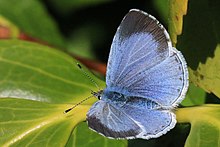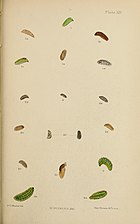Holly blue
| Holly blue | |
|---|---|

| |
| Male | |

| |
| Female both Cumnor Hill, Oxford, England | |
| Scientific classification | |
| Domain: | Eukaryota |
| Kingdom: | Animalia |
| Phylum: | Arthropoda |
| Class: | Insecta |
| Order: | Lepidoptera |
| Family: | Lycaenidae |
| Genus: | Celastrina |
| Species: | C. argiolus
|
| Binomial name | |
| Celastrina argiolus | |
| Synonyms | |
| |
The holly blue (Celastrina argiolus)[2] is a butterfly that belongs to the lycaenids or blues family and is native to the Palearctic.
Description
[edit]
The holly blue has pale silver-blue wings spotted with pale ivory dots. Seitz describes it "Male above shining violet blue, only the apical portion of the costal margin being minutely edged with white. The female has both wings broadly bordered with dark, the margin of the hindwing bearing vestiges of ocelli. Underside silver-white, in the disc a row of black dots, some of which are elongate, and before the margin blackish shadowy dots. Egg very flat, whitish. Larva green or brown, marked with yellowish white, bearing catenulate (chain-like) stripes on the back, on segment 7 a gland to attract ants; head brown. On Ivy, Ilex, Euonymus, Rhamnus, Robinia, Genista, Spartium, Astragalus, Rubus, Erica, Pyrus and many other plants; in Europe visited usually by ants of the genus Lasius; in June and the autumn. Pupa mostly fastened to the underside of a leaf, ochreous with brown spots and markings. The butterflies in the spring and again in July, occasionally a third time at the end of August and in September, everywhere common, particularly at the flowers of ivy and brambles."[3] In Europe, the first generation feeds mainly on the holly species Ilex aquifolium but the second generation uses a range of food plants.[4]
The holly blue is the national butterfly of Finland.[5]
Taxonomy
[edit]This species was originally described as Papilio argiolus by Carl Linnaeus in 1758, and refers to the examples flying in Europe. In their monograph on the Lycaenopsis group of polyommatine genera, Eliot & Kawazoe, 1983, list 14 taxa as valid subspecies names, plus many further synonyms to which they accord lesser status. According to Eliot & Kawazoe, 1983, these 14 subspecies are divided into four groups as follows:
Palaearctic & North African
South and South-East Asian
|
Far Eastern
|
Common names
[edit]In India, C. argiolus is known as the hill hedge blue.[6]
-
female laying egg, Bulgaria
-
Egg
-
Imago
-
Female
-
Bottom sides of the wings
-
Male
Range
[edit]Found in Eurasia. In South Asia, it occurs from Chitral in Pakistan to Kumaon in India.[6]
Population cycle
[edit]The holly blue is subject to marked population cycles which appear to be caused by interactions with the parasitoid ichneumon wasp Listrodromus nycthemerus. The wasp lays an egg on a holly blue caterpillar, inserting the egg into the caterpillar's body and the adult wasp emerges from the chrysalis, killing the chrysalis before its emergence. The population of the butterfly is tracked by that of the wasp, when butterfly populations are low the wasp population falls and this allows the butterfly population to increase and the population of L. nycthemerus can increase as there are more hosts available to be parasitised. As more caterpillars are parasitised the butterfly population crashes.[7]
See also
[edit]- List of butterflies of India
- List of butterflies of India (Lycaenidae)
- List of butterflies of Great Britain
References
[edit]- ^ van Swaay, C.; Wynhoff, I.; Verovnik, R.; et al. (2010). "Celastrina argiolus (Europe assessment)". IUCN Red List of Threatened Species. 2010: e.T174235A7033895. Retrieved 13 June 2023.
- ^ Beccaloni, G.; Scoble, M.; Kitching, I.; Simonsen, T.; Robinson, G.; Pitkin, B.; Hine, A.; Lyal, C., eds. (2003). "Celastrina argiolus". The Global Lepidoptera Names Index. Natural History Museum. Retrieved April 20, 2018.
- ^ Seitz, Adalbert, ed. (1909). Die Großschmetterlinge des palaearktischen Faunengebietes. Band 1: Die palaearktischen Tagfalter. Vol. 1. p. 322. Retrieved 2023-01-11.
- ^ Butterfly Conservation A-Z of butterflies Archived 2010-06-20 at the Wayback Machine
- ^ "Finland's national butterfly is the holly blue - Suomi 100". suomifinland100.fi. Archived from the original on 2018-06-19. Retrieved 2017-08-01.
- ^ a b Evans, W.H. (1932). The Identification of Indian Butterflies (2nd ed.). Mumbai, India: Bombay Natural History Society. pp. 221–226, ser no H21.24.
- ^ "Holly Blue defies predatory wasp - Big Butterfly Count results". Butterfly Conservation. 9 October 2015. Retrieved 13 June 2023.
- Beccaloni, George; Scoble, Malcolm; Kitching, Ian; Simonsen, Thomas; Robinson, Gaden; Pitkin, Brian; Hine, Adrian; Lyal, Chris. "The Global Lepidoptera Names Index (LepIndex)". Natural History Museum, London. Retrieved 2016-10-15.
- Eliot, J. N. and Kawazoe, A., 1983. Blue butterflies of the Lycaenopsis group: 1–309, 6 pls. London.
- Evans, W.H. (1932). The Identification of Indian Butterflies (2nd ed.). Mumbai, India: Bombay Natural History Society.
- Willmott, Ken and Freed, Tim (1999). The Holly Blue Butterfly. Butterfly Conservation, Colchester, UK, 20p. ISBN 0-9522602-7-1.
- "Celastrina argiolus". Integrated Taxonomic Information System. Retrieved 6 February 2006.
External links
[edit]- Savela, Markku. "Celastrina argiolus (Linnaeus, 1758)". Lepidoptera and Some Other Life Forms. Archived from the original on April 3, 2018. Retrieved April 3, 2018.







